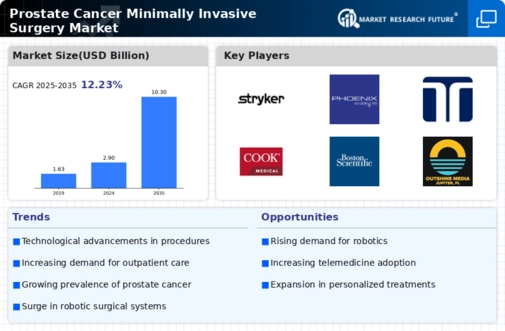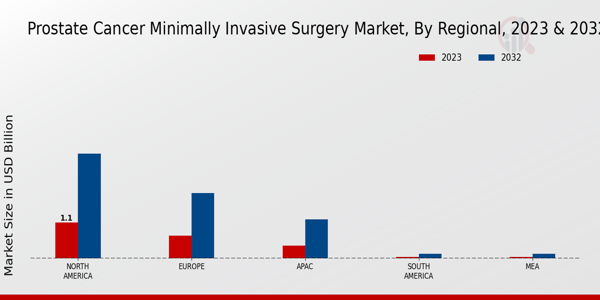Market Growth Projections
The Global Prostate Cancer Minimally Invasive Surgery Market Industry is poised for substantial growth, with projections indicating a rise from 2.9 USD Billion in 2024 to 10.3 USD Billion by 2035. This growth trajectory suggests a compound annual growth rate of 12.23% from 2025 to 2035, reflecting the increasing demand for effective and less invasive treatment options for prostate cancer. The market dynamics are influenced by various factors, including technological advancements, rising incidence rates, and changing patient preferences, all contributing to a robust and evolving landscape for minimally invasive surgical procedures.
Rising Incidence of Prostate Cancer
The increasing prevalence of prostate cancer globally serves as a primary driver for the Global Prostate Cancer Minimally Invasive Surgery Market Industry. As awareness and screening efforts improve, more cases are being diagnosed, leading to a heightened demand for effective treatment options. In 2024, the market is projected to reach 2.9 USD Billion, reflecting the urgent need for innovative surgical techniques. This trend is expected to continue, with the market anticipated to grow significantly as the number of diagnosed cases rises, necessitating advancements in minimally invasive surgical procedures.
Supportive Government Policies and Funding
Supportive government policies and funding for cancer research and treatment are vital to the growth of the Global Prostate Cancer Minimally Invasive Surgery Market Industry. Governments worldwide are increasingly recognizing the importance of addressing cancer as a public health priority, leading to increased funding for research and development of innovative surgical techniques. These initiatives not only enhance the availability of advanced treatment options but also encourage collaboration between public and private sectors. As a result, the market is likely to benefit from enhanced resources and support, fostering an environment conducive to growth and innovation.
Growing Awareness and Education Initiatives
Enhanced awareness and education initiatives regarding prostate cancer and its treatment options are crucial drivers of the Global Prostate Cancer Minimally Invasive Surgery Market Industry. Campaigns aimed at educating the public about the risks and benefits of early detection and treatment are leading to increased screening rates and, consequently, more diagnoses. As patients become more informed about their treatment options, the demand for minimally invasive surgeries is likely to rise. This growing awareness is expected to contribute to the market's expansion, with projections indicating a substantial increase in market value over the coming years.
Increasing Demand for Outpatient Procedures
The shift towards outpatient procedures is significantly influencing the Global Prostate Cancer Minimally Invasive Surgery Market Industry. Patients increasingly prefer treatments that allow for quicker recovery and less hospital time, which aligns with the characteristics of minimally invasive surgeries. This trend is likely to result in a higher volume of procedures being performed in outpatient settings, further driving market growth. As healthcare systems adapt to this demand, the market is expected to witness a compound annual growth rate of 12.23% from 2025 to 2035, reflecting the evolving preferences of patients and healthcare providers alike.
Technological Advancements in Surgical Techniques
Technological innovations in surgical techniques are transforming the landscape of the Global Prostate Cancer Minimally Invasive Surgery Market Industry. The introduction of robotic-assisted surgeries, enhanced imaging technologies, and minimally invasive approaches has improved surgical outcomes and reduced recovery times. These advancements not only enhance patient satisfaction but also drive market growth. As hospitals and surgical centers adopt these technologies, the market is expected to expand, with projections indicating a growth to 10.3 USD Billion by 2035. The integration of cutting-edge technology is likely to play a pivotal role in shaping future surgical practices.









